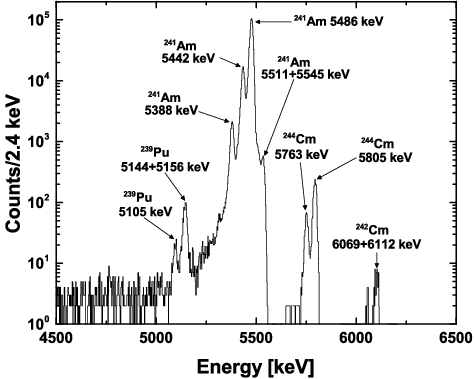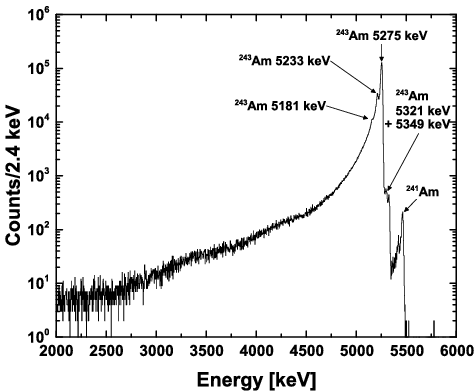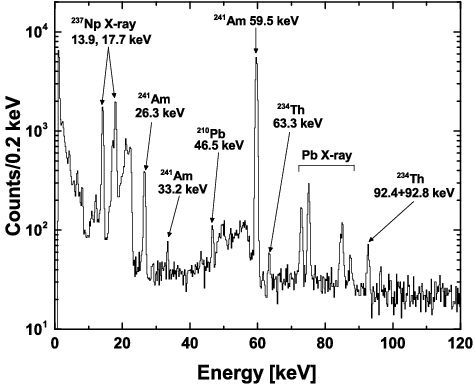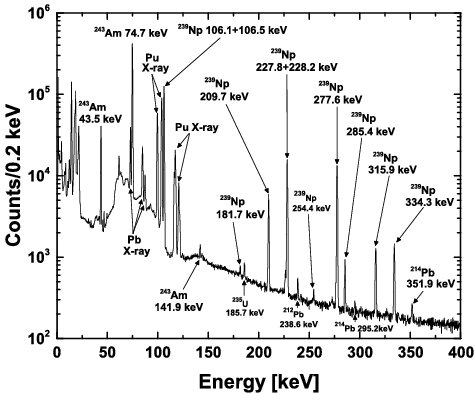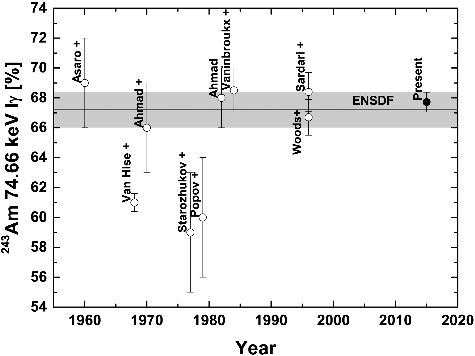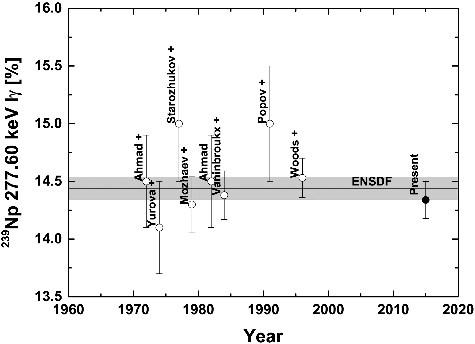 ?Mathematical formulae have been encoded as MathML and are displayed in this HTML version using MathJax in order to improve their display. Uncheck the box to turn MathJax off. This feature requires Javascript. Click on a formula to zoom.
?Mathematical formulae have been encoded as MathML and are displayed in this HTML version using MathJax in order to improve their display. Uncheck the box to turn MathJax off. This feature requires Javascript. Click on a formula to zoom.ABSTRACT
Gamma-ray emission probabilities of 241, 243Am and 239Np have been precisely measured with gamma- and alpha-ray spectroscopic methods. The activities of the samples were determined by measuring alpha particles using a Si semiconductor detector. Gamma rays emitted from the samples were measured with a planar type High-Purity Germanium (HPGe) detector. An efficiency curve of the HPGe detector was derived with uncertainties from 0.7% to 2.5% by combining measured efficiencies and Monte Carlo simulation. The gamma-ray emission probabilities for the major gamma rays of these nuclides were determined with uncertainties less than 1.2%.
1. Introduction
Accurate neutron capture cross sections of minor actinides (MAs) are required for the R&D of innovative nuclear systems and environmental load reduction from the disposal of nuclear wastes. However, there are differences of more than a factor of 2 between required accuracies and current accuracies [Citation1]. For example, current accuracies are 6% for the 237Np capture cross section in the neutron energy region from 0.5 to 500 keV, 8% for 241Am, and 10% for 243Am from 0.5 to 1350 keV. On the other hand, required accuracies are 3% for 237Np, 2% for 241Am, and 2% for 243Am. To meet the requirement, time-of-flight (TOF) measurements of capture cross sections of MAs have been performed in recent years to improve reliabilities of the cross sections for MAs at several spallation neutron source facilities: Japan Proton Accelerator Research Complex (J-PARC) [Citation2–4], CERN [Citation5] and LANL [Citation6]. In spite of the attempts, there are sometimes discrepancies among previous measurements deviating from their uncertainty ranges. Thus, in order to provide precise cross sections of MAs, a research project entitled ‘Research and development for Accuracy Improvement of neutron nuclear data on Minor ACtinides (AIMAC)’ has been started. The purpose of the project is to reduce the uncertainties of the capture cross sections of 237Np and 241, 243Am to half of the present values.
To achieve these goals, precise determination of the sample mass used in TOF measurements is essential, because uncertainties due to the sample mass propagate directly to those of measured cross sections over the entire neutron energy region. However, the uncertainties of the mass of the sample are not even identified in some cases, resulting in unrecognized systematic uncertainties. Furthermore, determination of the sample mass is also important for normalization of the measured relative cross sections. Currently, neutron energy dependence of the capture cross sections of MAs has been determined with high precision by previous measurements with the Accurate Neutron Nucleus Reaction measurement Instrument (ANNRI) at the Materials and Life science experimental Facility (MLF) at J-PARC. However, relative cross sections obtained by TOF measurements are normalized to absolute cross sections by using the thermal cross section or an evaluated value at a large resonance, and as such, a large uncertainty corresponding to this normalization still remains. This is due to large uncertainty corresponding to the sample mass. Therefore, we focus on accurate quantitative determination of MA in sealed samples by measuring decay gamma rays emitted from the sample to reduce the uncertainty caused by the uncertainties of the sample mass. There are two reasons for the above results: it is preferable that quantifying method should be non-destructive because we have to handle the highly radioactive samples with activities on the order of hundreds of MBq. Additionally, handling of the unsealed samples is prohibited for radiation security at J-PARC. However, in order to determine the mass of MA in the sample with high precision, accurate data on relevant gamma-ray emission probabilities are required. Hence, as a part of the AIMAC project, this study is aimed to develop a technique for accurate determination of the mass of 237Np and 241, 243Am samples with gamma- and alpha-ray spectroscopic methods, and to provide gamma-ray emission probabilities with high precision (<2%), considering the required precision for MA cross sections.
Up to the present, the gamma-ray emission probabilities of 241Am have been obtained [Citation7–19]. In the recent study of Iwahara et al. [Citation18], a 4π(proportional counter) α–γ coincidence method and a liquid scintillator were used for 241Am activity determination, and the gamma-ray emission probability of 59.54 keV was determined with a relative uncertainty of 0.47% using a calibrated planner type Ge detector. The gamma-ray emission probabilities of 243Am and 239Np have been measured [Citation20–27]. Woods et al. [Citation27] applied the 4π(PC) α-γ coincidence method for activity determination and gamma-ray spectrometry with an intrinsic Ge detector. The gamma-ray emission probabilities of 74.66 keV in the decay of 243Am and 277.60 keV in the decay of 239Np were determined with relative uncertainties of 1.8% and 1.2%, respectively. On the other hand, the sample activity can be accurately determined by measuring alpha-particles emitted from the sample using a Si detector. Additionally, in most previous experiments, the full-energy-peak efficiencies of gamma-ray detectors were calibrated at a relatively short source–detector distance of about 10 cm, and the efficiency curve was typically determined with uncertainties larger than about 1.0% using a polynomial fitting function. Furthermore, contributions caused by cascade- and coincidence-summing effects were not negligible (<1). In order to overcome these difficulties, extremely accurate interpolation method proposed in [Citation28] has been incorporated in this work, where Monte Carlo simulation method taking into accounts physical parameters of Ge detector is applied. Furthermore, we chose a large distance between a Ge detector and a sample so as to be able to neglect cascade summing corrections.
From the viewpoint described above, we measured the gamma-ray emission probabilities of 241, 243Am at first. Additionally, measurements of 239Np, which is the daughter of 243Am and in equilibrium with 243Am, were carried out at the same time. The activities of the samples were obtained using a Si semiconductor detector by counting alpha-particles from the samples, and decay gamma rays were measured with a planar type High-Purity Germanium (HPGe) detector. Efficiencies at various energies were experimentally measured, and then the Monte Carlo code PHITS [Citation29] was used to interpolate these values.
In the present paper, the experimental procedures are briefly described in Section 2. The Monte Carlo calculations using the PHITS are summarized in Section 3. The results and discussions are given in Section 4. Finally, the conclusion is given in Section 5.
2. Experiments
2.1. Alpha-ray measurements
Americium-241 is an alpha-decay nuclide with a half-life of 432 years. Decay data, half-lives, radiation energies, emission probabilities and nuclear structure were taken from the Evaluated Nuclear Structure Data Files (ENSDF) [Citation30]. shows the simplified decay scheme of 241Am. A standard source of 241Am (AM241EASD20) supplied from AREVA was used for an efficiency calibration. The 241Am was electrodeposited in a circle having a diameter of 15 mm on a steel disk with a diameter of 30 mm and a thickness of 0.5 mm. The activity of the 241Am source was 352 Bq ± 0.5% as a 1σ value measured by an ionization chamber according to the certification sheet. Alpha particles emitted from the source were measured using a Si detector (BU-016-300-100) of 300 mm2 active area manufactured by ORTEC. The distance between the source and the front surface of the detector was 43 mm. shows an example of the alpha-ray spectrum of the 241Am source. The energy resolution at 5486 keV (241Am alpha-ray) was 20 keV. Four peaks were caused by 241Am alpha-rays from 5400 to 5600 keV. In addition, 239Pu and 242, 244Cm impurities were observed in the spectrum. Contribution of alpha impurities of 239Pu and 242, 244Cm was 0.34% determined from their peak intensities in the spectrum and was in accordance with the certification sheet. Other impurities in the source were not observed. The obtained detection efficiency of the Si detector was 1.141 ± 0.006%.
Figure 1. Simplified decay scheme of 241Am. Alpha-ray energies and intensities are described [Citation30].
![Figure 1. Simplified decay scheme of 241Am. Alpha-ray energies and intensities are described [Citation30].](/cms/asset/26b0e03e-654f-492f-aa2b-e7c2a23f5ab7/tnst_a_1174167_f0001_b.gif)
Americium-243 undergoes alpha decay with a half-life of 7370 years and produces 239Np, which is in radioactive equilibrium with 243Am due to short half-life of 2.35 days [Citation30]. shows the simplified decay scheme of 243Am and 239Np. A 243Am source was prepared using standard solution (AmCl3 in 1 M HCl) supplied by Japan Radioisotope Association. Its specific radioactivity was 39.6 ± 1.2 kBq/g. 10 μl of 243Am solution was dropped on a high-purity quartz plate, and dried by an infrared lamp. Three measuring samples were prepared in the same manner. Their diameters and radioactivities were approximately 5–7 mm and 1 kBq, respectively. The thicknesses of the samples were sufficiently thin, thus preventing self-absorption of alpha-rays in the samples. The activities of the samples were determined by counting alpha particles with the Si detector. The samples were placed at a distance of 43 mm from the Si detector. indicates the alpha-ray spectrum from one of the 243Am samples. A sharp peak located at 5250 keV is due to the alpha particles from the decay of 243Am. The tail of the spectrum is long due to the thickness of the 243Am samples. Contribution of alpha-particles from 241Am inside the samples was very small. The absolute detection efficiencies of the Si detector were determined by using the 241Am standard source as mentioned above. The main uncertainty comes from the activity of the source. Assuming that the 243Am samples and the 241Am were circular, corrections for solid angle between the samples and the source were made analytically. The correction factors were ranging from 1.015 to 1.018 corresponding to the diameters of the samples. We verified the activities of the samples by changing the source–detector distance, and the reliability for the correction was confirmed. Additionally, by using a thin 243Am sample, the tail of the alpha peak was lowered, and no impurities were detected.
Figure 3. Simplified decay scheme of 243Am. Alpha-ray energies and intensities are described. Transition intensities by beta minus decay are also shown [Citation30].
![Figure 3. Simplified decay scheme of 243Am. Alpha-ray energies and intensities are described. Transition intensities by beta minus decay are also shown [Citation30].](/cms/asset/75c6c115-420b-48fa-bb6f-60c266ba95ab/tnst_a_1174167_f0003_b.gif)
2.2. Gamma-ray measurements
Gamma rays emitted from the source were measured with a 36 mm × 13 mm planar-type low-energy photon HPGe detector (GLP-36360/13P4) manufactured by ORTEC. The detector was composed of a p-type Ge crystal and a Be window with a thickness of 0.254 mm, where the cap-to-crystal distance was 7 mm. The X-COOLER III made by ORTEC was utilized for cooling of the HPGe detector. Signals from the HPGe detector were fed to a Lynx digital signal analyzer made by CANBERRA and spectral data were recorded on a PC. The energy resolution at 122 keV (57Co gamma ray) was 0.6 keV. All measurements were performed with a source–detector distance of 20.0 cm in taking account of the thickness of the samples. Uncertainty of the distance was less than 0.3 mm and having negligible influence on the measured efficiencies and peak areas of interest. shows the gamma-ray spectrum from the decay of 241Am measured for 25 h. The peak around 60 keV is due to 241Am 59.54 keV decay gamma rays. The statistical uncertainties were about 3.6% and 0.75% for 26.34 and 59.54 keV of 241Am, respectively. There were no peaks seen in the spectrum caused by impurities except for the room background.
The three 243Am samples were measured with the HPGe detector for the determination of the gamma-ray emission probabilities of 243Am and 239Np. The total measuring time for each sample was 17 days at longest. shows an example gamma-ray spectrum from the 243Am samples. Two strong gamma rays from the decay of 243Am were measured at the energies of 43.53 and 74.66 keV. Above 100 keV, several decay gamma rays were observed corresponding to the gamma-ray emissions from 239Np. We could not separate the 106.12 and 106.47 keV gamma rays from the decay of 239Np, so a combined gamma-ray emission probability was obtained. Around 100 keV, Pu K X-rays were measured. No existence of impurities was found the spectrum.
Full-energy peak efficiencies of the detector were determined with measurements of standard gamma-ray sources and Monte Carlo calculations using PHITS code [Citation29]. First, the efficiencies were measured using three individual sources supplied by AREVA and DAMRI (60Co, 137Cs, 133Ba) with activities of 40.6 ± 0.3, 37.7 ± 0.38 and 35.2 ± 0.24 kBq with standard deviation of 1σ. Measurements of the standard sources were carried out for a long period of time to reduce statistical uncertainties in peak areas. The dead time was less than 0.04% due to small count rates (<100 cps). Peak areas were obtained by simultaneously fitting a Gaussian, a skewed Gaussian and a smoothed step function. The skewed Gaussian shows contribution of incomplete charge collection. The smoothed step function indicates contributions from incomplete charge collection effects and Compton scattering of gamma rays in the detector. X-rays from 137Cs and 133Ba were used to confirm the reliability of the efficiencies at low energies and the contribution from Ge X-ray escape effects. The efficiencies were determined with the obtained peak areas, the absolute activities of the sources and gamma-ray emission probabilities of the 60Co, 137Cs, 133Ba nuclides. For the standard sources, evaluated data of half-lives and gamma-ray emission probabilities were taken from the International Atomic Energy Agency (IAEA) [Citation31]. Contribution from cascade summing was small (<0.3%) for the measurements made at 20.0 cm. Corrections for cascade summing were estimated from Monte Carlo calculations using the PHITS code. The same geometry for the detector and shielding as the actual one was created in the input data, and total detection efficiency of the detector was obtained. Then, peak-to-total ratio curve was calculated and compared with that by measurements of 241Am, 137Cs and 60Co standard sources. The difference between the measurements and the calculations was less than 15%. Finally, contribution from cascade summing was derived and was small (<0.3%). The obtained efficiencies were between 0.004% and 0.2% in the energy range from 32 to 1332 keV shown in (a). Then, the Monte Carlo simulation using the PHITS were made for interpolation of the measured efficiencies. This will be discussed in detail in section 3.
Figure 7. The full-energy-peak efficiency is plotted in the top figure (a). The filled points show measured efficiencies using the standard sources of 60Co and 133Ba at a source distance of 20.0 cm. The solid line indicates the calculated efficiencies from the Monte Carlo calculation. Differences between the measured efficiencies and the calculated values using the PHITS are compared in the bottom figure (b). Open circles represents the data obtained by using the 137Cs source, which were normalized to unity at 662 keV. The estimated uncertainties of the efficiency curve were shown by the gray area in the figure.
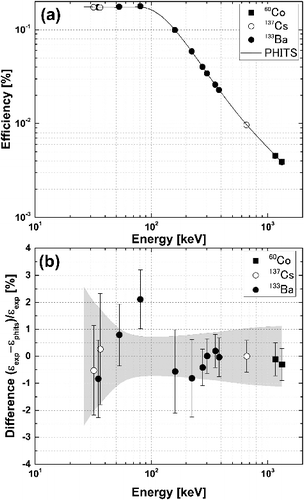
3. Monte Carlo simulations
The efficiency curve was interpolated by PHITS calculations. The same geometry was created including the air between the source and the detector, and the validity of the simulation was checked. indicates the upper half of the cross section of the detector used in the PHITS calculations. Then, the parameters of the HPGe detector (radius, length and dead layer thickness) were modified to match the results of measurements. The calculations were repeated until the statistical uncertainty of the full-energy-peak efficiency becomes less than 0.1%. The length of the HPGe detector was mainly determined so as to reproduce the measured efficiencies with the 60Co source. In low-energy regions below 40 keV, efficiencies are strongly dependent on the thickness of the frontal dead layer. We obtained the dead layer thickness of 1.58 μm with K X-rays from 133Ba at 35.00 keV and 137Cs at 32.04 and 36.51 keV. The detector radius was determined considering with the entire consistency from 32 to 1332 keV. In this way, we obtained the parameters of the HPGe detector. summarizes the determined parameters and specifications by the manufacturer. (a,b) compares the results of the measurements and PHITS. In the case of 137Cs, measured relative efficiencies were normalized to the calculated efficiency at 662 keV in order to confirm the agreement in low-energy regions with K X-rays at 32.04 and 36.51 keV, because the uncertainty of absolute activity of the 137Cs source is large and discrepancy of the normalization factor exists. Error bars of the points in (b) include uncertainties from the Monte Carlo calculation and measured efficiencies considering the covariances, uncertainties due to photon emission rates, statistics and the activities of the sources. The PHITS calculations were in good agreement with the measured efficiencies with a reduced χ2 of 1.76.
Figure 8. Geometry of the HPGe detector in the PHITS calculations. The upper half of the detector is illustrated in the figure.
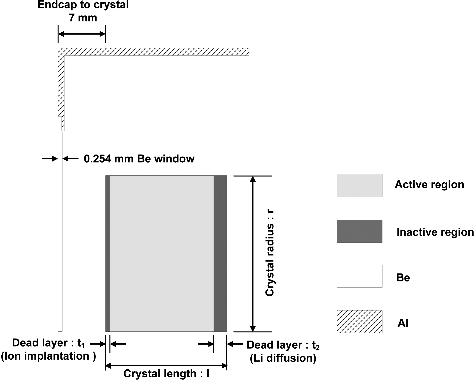
Table 1. Parameters of the HPGe detector. Specifications by the manufacturer are compared with the PHITS calculations. Uncertainties of these parameters estimated by the PHITS calculations are shown.
The uncertainties of the efficiency curve were determined from 0.7% to 2.5% ranging from 25 to 1332 keV by calculating the chi-square surface as a function of the input parameters of the PHITS. (b) shows the determined uncertainties. We inspected changes in the chi-square value by varying the detector radius, length and the dead layer thickness. When the chi-square value is between χ2min and χ2min + 1 [Citation32], the possible ranges of these parameters were deduced as their uncertainties and are summarized in . Finally, the uncertainties of the efficiency curve were evaluated according to the deduced parameter ranges. The uncertainties become larger due to the dead layer thickness below 50 keV. A dominant contribution is caused by the radius around 100 keV, and the detector length has a large contribution above 200 keV. The efficiency of 26.34 keV gamma rays emitted from 241Am was determined by extrapolation using the PHITS, and the accuracy of the calculated efficiency was estimated as 2.5% due to the uncertainties of the dead layer thickness and the crystal radius. Furthermore, the ratio between full-energy-peak area and escape peak areas of Ge K X-ray was estimated using the PHITS below 100 keV, and corrections due to Ge X-ray escape effects were determined. Contribution of the Ge X-ray escape effects increased with a decrease of gamma-ray energy, and it was found to be 2.3% and 0.4% at 26.34 and 59.54 keV, respectively. Ten percent of the corrections were estimated to be the uncertainties in comparison with the measured gamma-ray spectrum.
4. Data analysis and results
Activities of the samples were determined by measuring alpha particles using the Si semiconductor detector. Activity (A) of the sample is defined as follows:
(1)
(1) where Yα is the yields of alpha particles, εα is the detection efficiencies of alpha particles; Iα is the alpha-ray emission probabilities from target nuclide and Tα is the measuring time. Similarly to the alpha-ray measurements mentioned above, activity of the sample was also defined as follows from gamma-ray measurements:
(2)
(2) where Yγ is the yields of gamma rays, εγ is the detection efficiencies of gamma rays, Iγ is the gamma-ray emission probabilities and Tγ is the measuring time.
The alpha-ray spectra were integrated to determine the yields of alpha particles (Yα). The detection efficiencies of alpha particles by the Si detector were obtained from the measurements of the 241Am standard source. Corrections for solid angles among the 241Am source and the created 243Am samples were carried out by geometric calculations on the assumption that the shape of 243Am samples was circle. The diameters of the 243Am samples were measured to be 6 ± 1 mm, including the distortion in the sample shape. The correction factor was 1.015–1.018 according to the diameters of the 243Am samples. The uncertainties for the corrections were estimated to be 10% due to the variations of measured diameters. Impurities contained in the 243Am samples were analyzed by preparing thin samples, and peaks owing to impurities overlapping with the alpha-ray spectrum of 243Am were not observed. For this reason, the contribution caused by impurities can be negligible. Finally, the activities of the samples were calculated with an uncertainty of 0.53%. The following items were taken into account for the uncertainties of the activities: the statistical uncertainties (≤0.05%), the uncertainty due to the activity of the 241Am source (0.5%), and the uncertainties from corrections for solid angle (≤0.2%).
Each peak in the measured gamma-ray spectra was fitted by the Gaussian function to derive the net area. We checked variations of the peak areas due to fitting process by changing background functions and the range of the background channels. Uncertainties of the peak areas determined by fitting were calculated to be 0.3%. Statistical uncertainties for intense gamma rays for 243Am and 239Np were lower than 0.6% and 0.4%, respectively. Similarly, peak areas were obtained by fitting for the efficiency calibration on each source. Uncertainties from dead time of the data acquisition was <0.04% due to a low counting rate of <100 cps.
The gamma-ray emission probabilities of 241, 243Am and 239Np were derived using the calculated efficiencies from the Monte Carlo simulation, the activities of the measuring samples and the peak areas for each peak. The obtained gamma-ray emission probabilities with a standard deviation of 1σ are given in Tables –. As for the gamma-ray emission probability of 106.12 keV from the decay of 239Np, there remains contribution of gamma rays of 106.47 keV (Iγ = 0.05% from ENSDF [Citation30]). Contributions from 74.97 Pb-Kα X-rays to 74.66 keV 239Np decay gamma rays were estimated by the spectral data of the standard source. Additionally, copper plates with thicknesses of 5 mm as the inner shielding were attached inside of Pb shields, and the contribution from Pb-X rays was eliminated. The following points were taken into consideration for the uncertainties of the gamma-ray emission probabilities: (1) statistical uncertainties corresponding to the peak areas for alpha- and gamma-counting; (2) the uncertainties caused by variation in fitting of the photopeaks (<0.3%); (3) the uncertainties due to the activity of 241Am source (0.5%); (4) the uncertainties from the calculated efficiencies (ranged from 0.7% to 2.5%); (5) uncertainties caused by the corrections for the dead time (<0.02%); (6) solid angle (<0.2%); (7) cascade summing (<0.05%); (8) Ge X-ray escape effects (<0.2%). The details of the uncertainties for 243Am were summarized in as one example.
Table 2. Gamma-ray emission probabilities of 241Am.
Table 3. Gamma-ray emission probabilities of 243Am.
Table 4. Gamma-ray emission probabilities of 239Np.
Table 5. Details of uncertainties for the gamma-ray emission probabilities of 243Am.
shows the measurement data of gamma-ray emission probabilities of 241Am at 59.54 keV in chronological order [Citation7–13,Citation15–18]. The evaluated value of ENSDF is also shown in the figure [Citation30]. In the latest measurement, Iwahara et al. [Citation18] measured the gamma-ray emission probabilities of 241Am with a 4π(PC) α–γ coincidence method and a liquid scintillator for 241Am activity determination. The gamma rays emitted from the sample were measured with a planar-type Ge detector. They determined the gamma-ray emission probabilities of 26.34 and 59.54 keV on 241Am as 2.06 ± 0.03% and 35.87 ± 0.17%, respectively. The present result of 59.54 keV on 241Am matches with their result within the limit of uncertainty. The difference among the two for 241Am 26.34 keV is 9.5%, which may be caused by difficulties for determination of a precise detector efficiency curve of a Ge detector in the low-energy region and low counting statistics due to a large emission rate, and overlap of Compton components from 59.54 keV gamma rays of 241Am and natural background.
Figure 9. Comparison of the gamma-ray emission probabilities of 59.54 keV of 241Am in chronological order. The gray area indicates the uncertainty of the evaluated value of ENSDF.
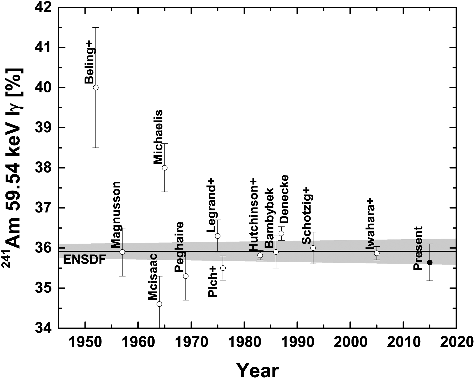
and show the measurement data for the gamma-ray emission probability of 74.66 keV from 243Am and 277.60 keV from 239Np in chronological order, respectively [Citation20–27]. The value from ENSDF is also shown in the figure [Citation30]. In the recent measurement, Woods et al. [Citation27] measured the decay scheme data of 243Am and 239Np using a 4π(PC) α–γ coincidence method for activity determination and an intrinsic Ge detector for gamma-ray measurement. They prepared the 243Am solution of 1.43 M HCl, and chemical separation of 243Am and 239Np was carried out by exchange chromatography. Thus, separated 239Np and an equilibrium mixture of 243Am and 239Np solution were used for gamma-ray measurements with a Ge detector. They reported the gamma-ray emission probabilities of 74.66 keV from 243Am and 277.60 keV from 239Np as 66.7 ± 1.2% and 14.54 ± 0.17%, respectively. Their results are in good agreement with the present results within an uncertainty range.
5. Conclusions
The gamma-ray emission probabilities of 241, 243Am and 239Np were measured with gamma- and alpha-ray spectroscopic methods. The radioactivities of the samples were determined with an accuracy of 0.5% by measuring alpha particles emitted from the samples by using the Si detector. The precise measurements and use of the Monte Carlo code PHITS gave the detection efficiencies of the HPGe detector with precisions ranging from 0.7% to 2.5% based on the chi-square surface. The gamma-ray emission probability of 59.54 keV of 241Am was obtained to be 35.64 ± 0.46%. Furthermore, the gamma-ray emission probabilities of 74.66 keV from 243Am and 277.60 keV from 239Np were derived as 67.72 ± 0.65% and 14.34 ± 0.16%, respectively. These gamma-ray emission probabilities were determined with uncertainties less than 1.2% and it is expected to contribute to accurate determination of the mass of 241, 243Am in the sample.
Acknowledgments
The authors would like to thank Dr Uehara and Dr Fujii of Kyoto University Research Reactor Institute for their support. Present study includes the result of ‘Research and Development for accuracy improvement of neutron nuclear data on minor actinides’ entrusted to the Japan Atomic Energy Agency by the Ministry of Education, Culture, Sports, Science and Technology of Japan (MEXT).
Disclosure statement
No potential conflict of interest was reported by the authors.
References
- Salvatore M, Jacqmin R. Uncertainty and target accuracy assessment for innovative systems using recent covariance data evaluations. WPEC-26, OECD NEA. San Diego (CA): Elsevier; 2008.
- Harada H, Ohta M, Kimura A, et al. Measurements of 241Am(n,γ) at J-PARC/MLF/ANNRI. Nucl Data Sheets. 2014;119:61–64.
- Kimura A, Fujii T, Fukutani S, et al. Neutron-capture cross-sections of 244Cm and 246Cm measured with an array of large Germanium detectors in the ANNRI at J-PARC/MLF. J Nucl Sci Technol. 2011;49:708–724.
- Hirose K, Furutaka K, Hara K, et al. Cross-section measurement of 237Np(n,γ) from 10 meV to 1 keV at Japan Proton Accelerator Research Complex. J Nucl Sci Technol. 2013;50:188–200.
- Mendoza E, Cano-Ott D, Guerrero C, et al. Measurement and analysis of the 243Am neutron capture cross section at the n_TOF facility at CERN. Phys Rev C. 2014;90:034608.
- Jandel M, Bredeweg TA, Bond EM, et al. Neutron capture cross section of 241Am. Phys Rev C. 2008;78:034609.
- Beling JK, Newton JO, Rose B. Soft radiations from 241Am. Phys Rev. 1952;86:797–798.
- Magnusson LB. Intensities of X-rays and γ rays in 241Am alpha decay. Phys Rev. 1957;107:161–170.
- McIsaac LD. Branching ratio for the 59.6 keV transition in the decay of 241Am. IOD Report. 1964;17052:31.
- Michaelis W. A study of the radiation from 241Am. Z Phys. 1965;186:42.
- Peghaire A. Accurate measurements of absolute intensities of γ radiation for α emitters. Nucl Instrum Methods. 1969;75:66.
- Legrand J, Perolat JP, Bac C, et al. Precise measurement of γ emission percentages of 141Ce (145 keV) and 241Am (59 keV). Int J Appl Radiat Isot. 1975;26:179.
- Plch J, Zderadicka J, Kokta L. Number of 59.5 keV photons per decay. Czech J Phys B. 1976;26:1344.
- Genoux-Lubain A, Ardisson A. The low-energy γ radiation accompanying α decay of 241Am. Radiochem Radioanal Lett. 1978;33:59–66.
- Hutchinson JMR, Mullen PA. Pin-well-NaI(Tl) counting of 59.5 keV γ rays in the decay of 241Am. Int J Appl Radiat Isot. 1983;34:543.
- Bambynek W. Decay data of the transactinium nuclides. IAEA; 1986. p. 128. ( Technical reports series no. 261).
- Denecke B. Measurement of the 59.5-keV gamma-ray emission probability in the decay of 241Am with a 4π-CsI(Tl)-sandwich spectrometer. Appl Radiat Isot. 1987;38:812–830.
- Iwahara A, Silvia MAL, Filho AEC, et al. Determination of disintegration rate and γ-ray emission probabilities of 65Xr and 241Am. Appl Radiat Isot. 2005;63:107–113.
- Moreira DS, Koshinas MF, Yamazaki IM, et al. Determination of 51Cr and 241Am X-ray and gamma-ray emission probabilities per decay. Appl Radiat Isot. 2010;68:596–599.
- Ahmad I, Wahlgren M. Long-lived standards for the efficiency calibration of Ge(Li) detectors. Nucl Instrum Methods. 1972;99:333.
- Yurova LN, Bushuev AV, Petrov UI, et al. Measurement of the absolute intensity of the 278 keV line of 239Np. Sov At Energy. 1974;36:52.
- Mozhaev VK, Dulin VA, Kazanskii YA. Absolute measurements of the branching ratio for the 277.6-keV Line of 239Np. Sov At Energy. 1979;47:556.
- Popov YS, Starozhukov DI, Mishenev VB, et al. Determination of the absolute yields of 43.5-, 74.7-, and 117.8-keV γ photons from 243Am. At Energy. 1979;46:111.
- Ahmad I. Alpha-particle-emission probabilities in the decay of 243U and photon-emission probabilities in the decays of 243U, 239Np and 243Am. Nucl Instrum Methods. 1982;193:9–13.
- Vaninbroukx R, Bortels G, Denecke B. Alpha-particle-emission probabilities in the decay of 243U and photon-emission probabilities in the decays of 243U, 239Np and 243Am. Int J Appl Radiat Isot. 1984;35:1081–1087.
- Sardari D, Mac Mahon TD, Holloway SP. 239U and 243Am decay data. Nucl Instrum Methods A. 1996;369:486–490.
- Woods SA, Woods DH, Woods MJ, et al. Standardisation and measurement of the decay scheme data of 243Am and 239Np. Nucl Instrum Methods Phys Res. 1996;369:472–476.
- Helmer RG, Hardy JC, Iacob VE, et al. The use of Monte Carlo calculations in the determination of a Ge detector efficiency curve. Nucl Instrum Methods A. 2003;511:360–381.
- Sato T, Niita K, Matsuda N, et al. Particle and heavy ion transport code system PHITS version 2.52. J Nucl Sci Technol. 2013;50:913–923.
- Evaluated Nuclear Structure Data File (ENSDF) for 241,243Am, 237,239Np and 239Pu. Database version of May 2015. Available from: www.nndc.bnl.gov/ensdf/index.jsp.
- International Atomic Energy Agency. Update of X ray and gamma ray decay data standards for detector calibration and other applications. IAEA-TECDOC-619. 2007;1:1–47.
- Eadie WT, Drijard D, James FE, et al. Statistical methods in experimental physics. Singapore: World Scientific; 1971.

